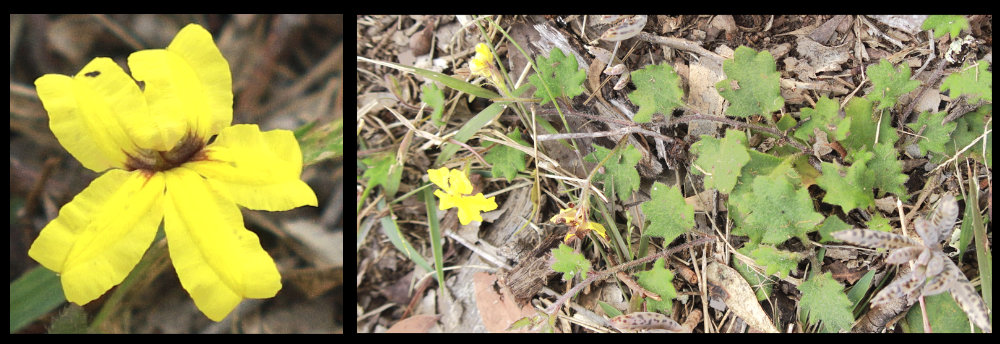Goodenia.
Family Goodeniaceae.
There are 170 to 180 (200) species most of which are endemic to Australia.
They are low shrubs or prostrate or erect herbs.
Some have stolons which are horizontal stems that root at the nodes.
There may be simple, branched or glandular hairs on various parts.
The variously shaped simple leaves are in a basal rosette or alternate along the stems.
Where both are present the leaves in the rosette may be different from those on the stem.
The blades sometimes form wings down the stem.
Blades can be linear, lanceolate, circular or ovate.
Hairs may be present or absent and there may be a basal lobe on one or both sides.
There are clusters of hairs in the axils of the leaf veins and the blade edges may have outward pointing teeth (dentate).
Axillary or terminal inflorescences are a solitary flower or a small cluster.
Flowers are on pedicels and there maybe bracts at the base.
Bracteoles are sometimes present and can be anywhere on the pedicel from the base to immediately under the ovary.
The bases of the (3) 5 sepals form a tube that is fused to the ovary with the lobes being free.
The bases of the petals form a short tube with 5 lobes on it.
There is sometimes a pouch or spur.
The bilaterally symmetric corolla is around 1 cm long.
There are 2 lobes on the upper lip and 3 on the lower and they all have wings.
The upper two petals are longer than the lower three.
The inside of the lobes may have small blunt projections (calli) or occasionally a few simple or barbed hairs.
These are tactile guides for the insect pollinators searching for the nectar.
Auricles are sometimes present on the upper 2 petals enclosing the indusium.
Flowers are almost always a pale or deep yellow and often have brown markings.
Occasionally flowers are mauve or pale pink.
Hairs may be present on the outer surface of the corolla.
They can be simple, stellate or glandular and lie flat on the surface or be more erect.
The 5 stamen filaments are free but the anthers are slightly stuck together forming a tube around the style.
The inferior ovary has 1 (2) locule with several ovules.
The single style has a squarish or 2 (4) lobed stigma.
There is usually only 1 indusium but there may be 4.
The indusium is usually cup-shaped but may be flat or folded downwards.
The edge can be smooth or have a notch or bristles.
The fruit are capsules with flat seeds with a wing or a thickened edge.
J.F.


